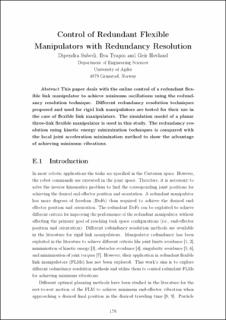| dc.contributor.author | Subedi, Dipendra | |
| dc.contributor.author | Tyapin, Ilya | |
| dc.contributor.author | Hovland, Geir | |
| dc.date.accessioned | 2022-09-28T14:00:17Z | |
| dc.date.available | 2022-09-28T14:00:17Z | |
| dc.date.created | 2022-03-22T09:05:41Z | |
| dc.date.issued | 2022 | |
| dc.identifier.citation | Subedi, D., Tyapin, I. & Hovland, G. (2022). Control of Redundant Flexible Manipulators with Redundancy Resolution. 2022 8th International Conference on Mechatronics and Robotics Engineering (ICMRE) (p. 116-121). IEEE. | en_US |
| dc.identifier.isbn | 978-1-6654-8377-3 | |
| dc.identifier.uri | https://hdl.handle.net/11250/3022339 | |
| dc.description | Author's accepted manuscript. | en_US |
| dc.description | © 2022 IEEE. Personal use of this material is permitted. Permission from IEEE must be obtained for all other uses, in any current or future media, including reprinting/republishing this material for advertising or promotional purposes, creating new collective works, for resale or redistribution to servers or lists, or reuse of any copyrighted component of this work in other works. | |
| dc.description.abstract | This paper deals with the online control of a redundant flexible link manipulator to achieve minimum oscillations using the redundancy resolution technique. Different redundancy resolution techniques proposed and used for rigid link manipulators are tested for their use in the case of flexible link manipulators. The simulation model of a planar three-link flexible manipulator is used in this study. The redundancy resolution using kinetic energy minimization techniques is compared with the local joint acceleration minimization method to show the advantage of achieving minimum vibrations. | en_US |
| dc.language.iso | eng | en_US |
| dc.publisher | IEEE | en_US |
| dc.title | Control of Redundant Flexible Manipulators with Redundancy Resolution | en_US |
| dc.type | Journal article | en_US |
| dc.type | Peer reviewed | en_US |
| dc.description.version | acceptedVersion | en_US |
| dc.rights.holder | © 2022 IEEE | en_US |
| dc.subject.nsi | VDP::Teknologi: 500::Maskinfag: 570 | en_US |
| dc.source.pagenumber | 116-121 | en_US |
| dc.source.journal | International Conference on Mechatronics and Robotics Engineering | en_US |
| dc.identifier.doi | https://doi.org/10.1109/ICMRE54455.2022.9734097 | |
| dc.identifier.cristin | 2011609 | |
| dc.relation.project | Norges forskningsråd: 237896 | en_US |
| cristin.qualitycode | 1 | |
